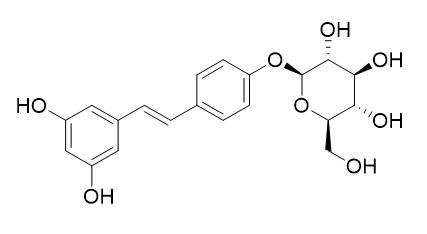Resveratroloside
Resveratroloside has cardioprotective effect, it exhibits α-glucosidase inhibitory activity, it also can inhibit hydroxylation of testosterone by CYP3A4. Resveratroloside has anti-inflammatory activity, it shows similar nitric oxide (NO) inhibition potency as that of piceid (the major constituent of P. cuspidatum).
Inquire / Order:
manager@chemfaces.com
Technical Inquiries:
service@chemfaces.com
Tel:
+86-27-84237783
Fax:
+86-27-84254680
Address:
1 Building, No. 83, CheCheng Rd., Wuhan Economic and Technological Development Zone, Wuhan, Hubei 430056, PRC
Providing storage is as stated on the product vial and the vial is kept tightly sealed, the product can be stored for up to
24 months(2-8C).
Wherever possible, you should prepare and use solutions on the same day. However, if you need to make up stock solutions in advance, we recommend that you store the solution as aliquots in tightly sealed vials at -20C. Generally, these will be useable for up to two weeks. Before use, and prior to opening the vial we recommend that you allow your product to equilibrate to room temperature for at least 1 hour.
Need more advice on solubility, usage and handling? Please email to: service@chemfaces.com
The packaging of the product may have turned upside down during transportation, resulting in the natural compounds adhering to the neck or cap of the vial. take the vial out of its packaging and gently shake to let the compounds fall to the bottom of the vial. for liquid products, centrifuge at 200-500 RPM to gather the liquid at the bottom of the vial. try to avoid loss or contamination during handling.
Plant Cell, Tissue and Organ Culture (PCTOC)2020, 143, 45-60(2020)
Molecules.2021, 26(9):2791.
Biomed Chromatogr.2022, 36(11):e5462.
Onco Targets Ther.2017, 10:3467-3474
Sains Malaysiana2024, 53(2):397-408.
Rep.Grant.Res.,Asahi Glass Foun.2023, No.119.
Plants (Basel).2023, 12(6):1259.
Viruses.2017, 9(10)
Plants.2024, 13(10):1348;
Food Bioscience2023, 52:102412
Related and Featured Products
J Tradit Complement Med. 2013 Jul;3(3):182-7.
Anti-inflammatory Activity of the Invasive Neophyte Polygonum Cuspidatum Sieb. and Zucc. (Polygonaceae) and the Chemical Comparison of the Invasive and Native Varieties with regard to Resveratrol.[Pubmed:
24716176]
Polygonum cuspidatum Sieb. and Zucc. has been traditionally used as a member of many anti-inflammatory polyherbal formulations, but is now a widespread invasive neophyte in Europe and America.
METHODS AND RESULTS:
To discuss if the invasive variety is chemically identical to the native one in traditional medicine, the different constituents of the invasive variety compared to the native variety were isolated and their anti-inflammatory activity was tested. Resveratroloside and catechin-(4α→8)-catechin, the newly found constituents in the invasive variety, have similar nitric oxide (NO) inhibition potency as that of piceid (the major constituent of P. cuspidatum), but the newly found major constituent, i.e., piceatannol glucoside, showed no apparent effect. On the other hand, as a marker, the total content of resveratrol in the methanol root extract after glucosidase hydrolysis was measured and compared between the invasive and native varieties.
CONCLUSIONS:
The total content of resveratrol measured in the root extracts of the Swiss sample was about 2.5 times less than that of the Chinese one.
This study brings attention to the point that when the invasive variety of P. cuspidatum is used in traditional medicine, the chemical difference should be kept in mind.
Cardiovasc Hematol Agents Med Chem. 2013 Sep;11(3):207-10.
Cardioprotective effect of resveratrol and resveratroloside.[Pubmed:
23547903]
METHODS AND RESULTS:
Cardioprotective effect of resveratrol and Resveratroloside was determined in ischemia-reperfusion experiments on rats. It was found that single intraperitoneal administration of any compound (10 mg/kg) followed by 30-min ischemia and 120-min reperfusion resulted in statistically significant decrease of myocardial infarct area (55.0±4.0% for control group; 40.7±4.4% for the group 1 received resveratrol; 41.6±4.8% for the group 2 received Resveratroloside).
CONCLUSIONS:
The cardioprotective effect of Resveratroloside was detected for the first time.
Biochem Biophys Res Commun. 2004 Oct 15;323(2):668-73.
Influence of lipophilicity on the interactions of hydroxy stilbenes with cytochrome P450 3A4.[Pubmed:
15369802 ]
Resveratrol, a polyphenol found in red wine, was recently suggested to act as an irreversible, mechanism-based inactivator of cytochrome P450 3A4 (CYP3A4).
METHODS AND RESULTS:
We found a significant inhibition of human CYP3A4-dependent transformation of cyclosporine by resveratrol, with IC50 = 4.5 microM. We studied the kinetics parameters of CYP3A4 transformation of resveratrol and structurally related, naturally occurring stilbenes. Resveratrol, piceid, Resveratroloside, 5,4'-dihydroxy-3-O-methoxystilbene, and 5,3-dihydroxy-4'-O-methoxystilbene were all shown to inhibit hydroxylation of testosterone by CYP3A4. Both methoxy-stilbenes had lower IC50 values, ranging from 0.43 to 0.47 microM, suggesting that lipophilicity rather than number or positions of free hydroxyls (3,5 or 5,4') determines the CYP3A4 inhibition capacity of polyphenols. In line with these findings, both glucosyl-stilbenes were found to be weak inhibitors of CYP3A4. The affinity of the enzyme towards methoxy-stilbenes, expressed as apparent Km, was indeed higher than those for the parent resveratrol and its glucosides, in CYP3A4 reaction mixtures. Vmax values were similar, except for piceid.
CONCLUSIONS:
These results support the role of lipophilicity in the interaction of polyphenols with CYP3A4. It is suggested that selective structural modifications of substrates add significantly to knowledge acquired through molecular modifications of the enzyme.
J Nutr Sci Vitaminol (Tokyo). 2012;58(4):278-86.
Analysis and functionality of major polyphenolic components of Polygonum cuspidatum (itadori).[Pubmed:
23132312]
Polygonum cuspidatum has been broadly utilized as a herbal medicine in Asia, but the outline of the polyphenol compounds in the plant has not been characterized well.
METHODS AND RESULTS:
In the present study, the major polyphenolic components were isolated from the roots of P. cuspidatum, and identified as resveratrol and its glucosides, Resveratroloside and polydatin. On the other hand, chlorogenic acid was found to be one of the polyphenolic components in the leaves and stems of the plant. Next, we elucidated that resveratrol derivatives and chlorogenic acid exhibit α-glucosidase inhibitory activities, and Resveratroloside exhibits the same inhibitory activity as quercetin does.
Furthermore, DPPH radical scavenging activities of antioxidants including resveratrol derivatives and chlorogenic acid derivatives were examined by initial rate analyses of their reactions.
Subsequently, it was revealed that resveratrol derivatives have slow-acting effects on the radical scavenging activity and that chlorogenic acid derivatives exhibit very fast-acting effects.



